Most Popular
Start Routing Notifications Today!
Courier is a notification service that centralizes all of your templates and messaging channels in one place which increases visibility and reduces engineering time.
Sign-up

Follow These Considerations For An Effective Push Notification System Design
On our smartphones or in our web browsers, push notifications are part of our daily online lives. Hate them or love them, when implemented correctly, they can be extremely valuable to our experiences.
An average of 20% of active website users opt in to receive web pushes, which, while the figure may seem low, is four times the best email subscription rate. The statistics are even higher on mobile devices, with 44% and 91% of iOS and Android users respectively opting in. Add in an average open rate that’s 50% higher than email, and you’ll see that push notifications have become an essential tool to drive user engagement and retention.
Yet, with the average U.S. smartphone user receiving 46 push notifications every day, our screens are fast becoming congested. Twenty-eight percent of users uninstall apps due to too many ads and messages, so you need to be mindful of sending the right notification to the right person at the right time. With that in mind, here are some key considerations for an effective push notification system design.
Convince users to opt in
According to an Asurion study, the average U.S. user checks their mobile phone “96 times a day — that’s once every 10 minutes.” Despite our best intentions to spend less time looking at our screens, Asurion found this figure reflected an increase of 20% in the last two years. While this might be due to us reaching for the next dopamine rush that comes with “anticipating or experiencing rewarding events,“ the same Asurion study found that almost 50% of smartphone users believed their devices helped them achieve a better work-life balance.
What does this have to do with convincing users to opt in to receiving your push notifications? Well, there’s an implied agreement we enter into when agreeing to receive pushes. If I am going to let you grab my attention, you need to make it worthwhile. Nothing irritates us faster than when a push notification doesn’t deliver on that dopamine promise.
Critical to the success of your app is convincing users to opt in to push notifications, as an Urban Airships benchmark report found. In their analysis of data from 63 million new app users, they found that “95% of new, opt-in app users churn within the first 90 days if they don’t receive any push notifications.“
Considering that you get one chance to ask for this necessary permission, you need to do it properly, clearly explaining the immediate value to the potential subscriber. It's the first notification you will send to your new user, and it sets the tone for your future engagements. Ask the user to opt in by highlighting the value before the generic dialog box can be beneficial. It has the added advantage that if the user denies your pre-permission ask, you can allow them some time to use your app, showing them your value before prompting them with the official request.
How many times have you opened a new website, only to be immediately disrupted by a dialog box asking you to subscribe to a newsletter? Asking for permission before you have demonstrated your value is too soon and is likely to waste your one chance of gaining consent.
Rather than a blanket all-in or all-out request, giving users control over which notifications they receive, at what frequencies, and over which channels can go a long way to increasing your opt-in rates. For example, the user may find it valuable to receive push notifications for a specific category, type, or event only, preferring to receive the rest via an email digest at the end of the day or week. Reserving push for important notifications only or prompting a user when a timely response is outstanding from another channel increases the focus on push notifications. It helps prevent the user from feeling overwhelmed and potentially disabling your pushes.
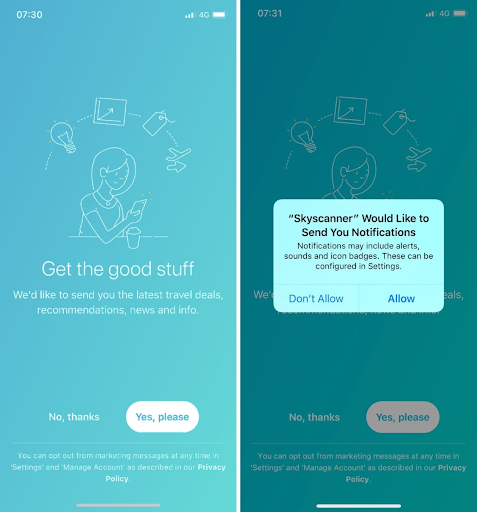
Skyscanner does a great job with their pre-permission ask.
Optimize your push notification design for the right device
Push notifications are more than a simple message. Capable of delivering dynamic and personalized content and supporting rich media (including GIFs, videos, and sounds), they are attention-grabbing by nature. But, each platform has its own design considerations, rules, and formats to which you need to cater.
Supported on mobile devices and almost any modern web browser, it can be a bit intimidating trying to wrap your head around the many design differences of each platform. What's possible from a design perspective can also depend on the OS (operating system) of the device, with push notification formats varying on the same web browser from one OS to another. Then, there are the changes that get rolled out with new OS versions, so you'll need to be mindful of this as well.
The tendency might be to design for the most common platform only, but not taking the various parameters of each platform into account can lead to self-sabotage. Don't let platform constraints turn your notifications into unclear or bland messages. Catering for these differences is essential in ensuring a good user experience, providing professional, impactful, and clear notifications to each device. Pushcrew found that rich web push notifications — those with banner images and call to action buttons — on average had more than a 33% greater click-through rate than those without.
While at the extreme ends of the spectrum, consider the difference between Chrome’s and Safari's web pushes. The former allows for a banner image, two action buttons, a 60-character title, and a 120-character body. However, the latter only provides for the basics of an icon, a 40-character title, and a 90-character body.
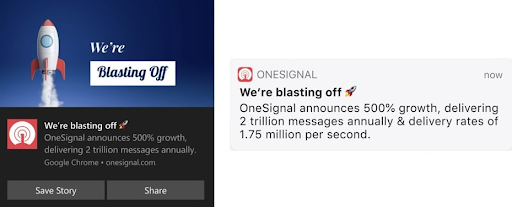
Web push notification differences between Chrome and Safari. Image source:OneSignal
Follow these best practices for your push notification system design
Now that you have permission to send pushes to your users, how do you ensure you keep up your end of the value exchange? According to Noah Weiss, VP of product at Slack, a great push notification is three things: timely, personal, and actionable. Let’s unpack this in more detail.
Ensure notifications are timely
Web pushes create a sense of urgency, and mobile devices are attention disrupting by their nature. To avoid annoying your recipients and sending them rushing for their opt-out settings, your disruption needs to be timely.
By timely, I don’t mean finding those hours when your users most engage with you and bombarding them with notifications (although it’s worth avoiding this behavior). Instead, your push notifications need to be actionable to the recipient at the time of receipt. Or, as the Collins Dictionary describes timely, an “event happens at a moment when it is useful, effective, or relevant.”
For this, you need contextual awareness, taking the user’s behavior, location, and preferences into account. For example:
- Understanding what a user typically does in your app on a Monday at 9 a.m.
- Reminding them of pending due dates on assigned tasks
- Linking to actions they have just performed on your website or in your app
Make messages personal
More than just a trick to increase open rates, today’s users expect personalized and relevant content. Personalized push notifications allow you to demonstrate an understanding of your user as an individual, with an awareness of their interest, use, and action within your app or website.
According to McKinsey & Company, “Today’s personalization leaders have found proven ways to drive 5 to 15 percent increases in revenue.” However, creating effective personalized notifications requires you to leverage your product and user data, using these insights to create more impactful and relevant push notifications.
Beyond simply segmenting your users based on their biographical data, overlay your product data with cohort analysis, which product analytics tool Amplitude describes as “the practice of grouping users by a particular trait.” The benefit of cohort analysis is that it reveals how different people use your product in different ways over time, adding richness to your segmentation.
Combining multiple data points when segmenting your user base will make it easier to send relevant pushes that are timely, personal, and actionable. For example, the language learning app Duolingo combines your location and the languages you are learning with the time you last accessed the app to deliver relevant messages to their users.
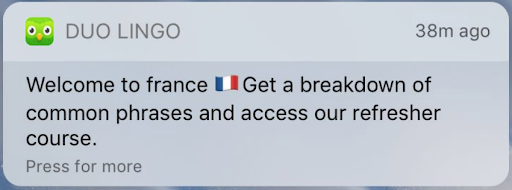
Duolingo combines multiple data points to send relevant notifications.
Create actionable content
For a successful push strategy, you need more than rich notifications. You need to build on the momentum of timely and personal events, continuing the journey into the app or browser, leading to that promised value.
The goal of sending actionable content is to encourage your users to (re-)engage with your product. It leads to a greater level of trust and, in turn, to a stronger relationship with your product and higher click-through rates of your future pushes. Even if your pushes are timely and personal, if they are only informative, chances are they won't lead to further action.
Here again, context and content will help make the push actionable. Consider how the meditation app Headspace uses a straightforward push of “Get some Headspace“ to make it immediately clear what the recipient should do next.

Headspace’s simple yet actionable notification.
Adhering to the above best-practice guidelines of timely, personal, and actionable will guarantee your push notification system design is respectful of your users’ trust and time. It will prevent you from overcommunicating, helping to ensure that you only send relevant information that offers value, including increasing productivity.
Measure the success of your push notifications
Any notification strategy requires the ongoing measurement of performance to evaluate its success. Especially with push notification system design, where adverse effects can lead to users unsubscribing or, worse, uninstalling your applications.
Define a set of metrics relevant to your product and industry vertical. Track these at a granular level. Be specifically aware of new trends and signs on the back of any changes or new notifications.
Commonly used metrics can include uninstalls, opt-out and opt-in rates, open rates, engagement rates over an X-day window, and the number of actions taken per X notifications sent.
Closely watch opt-out and uninstall rates, because they impact user retention. These two metrics will quickly indicate how relevant and timely your users perceive your pushes to be.
A low opt-in rate could mean you are not adequately demonstrating the value at the time of requesting permission. Drill down into the metrics per platform. Mobile devices with the Android OS assume permission when the user downloads the app. For Apple's iOS and browsers, explicit consent is needed.
The click-through rate is a good indicator of the timely and actionable nature of your messages. Does it lead to an increase in user engagement with your app or website within a defined period of sending your push?
It’s also a good practice to test and compare the success across channels at a per notification level. You may find that some notifications have the same success regardless of the channel used or a higher success rate over another channel like email. The results will help you optimize your push notifications, reserving push for the messages most effective over this channel only and decreasing your opt-out rates.
Incorporate push notifications into your communications strategy
While push notifications are incredibly powerful on their own, as part of a multichannel communications approach, they offer exciting opportunities to increase user acquisition, retention, and engagement. Reserved for important messages or used to prompt users for action when they haven't responded over another channel, push notifications provide you with another means of differentiating your messages.
With Courier's single API call approach, allowing you to design once and then deliver to any channel through one standard API, it's straightforward to incorporate new channels like push into your notification strategy without introducing complexity.
Start Routing Notifications Today!
Courier is a notification service that centralizes all of your templates and messaging channels in one place which increases visibility and reduces engineering time.
Sign-up
More from Engineering
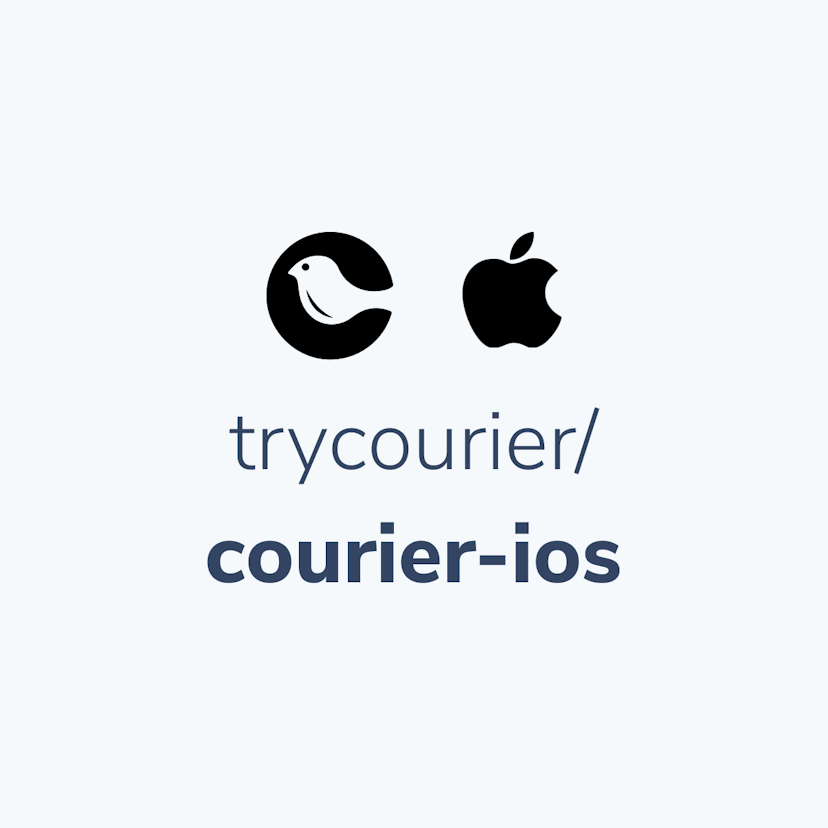
Simplifying notifications with the Courier iOS SDK
Push notifications are a valuable tool for keeping users informed and increasing their engagement with your app. You can use push notifications to alert users about promotions, new content, or any other important updates. While push notifications are a powerful tool, setting up push notifications in iOS can be a daunting task that requires a significant amount of effort and time. Fortunately, the Courier iOS Mobile Notifications Software Development Kit (SDK) simplifies this process.
Mike Miller
March 23, 2023
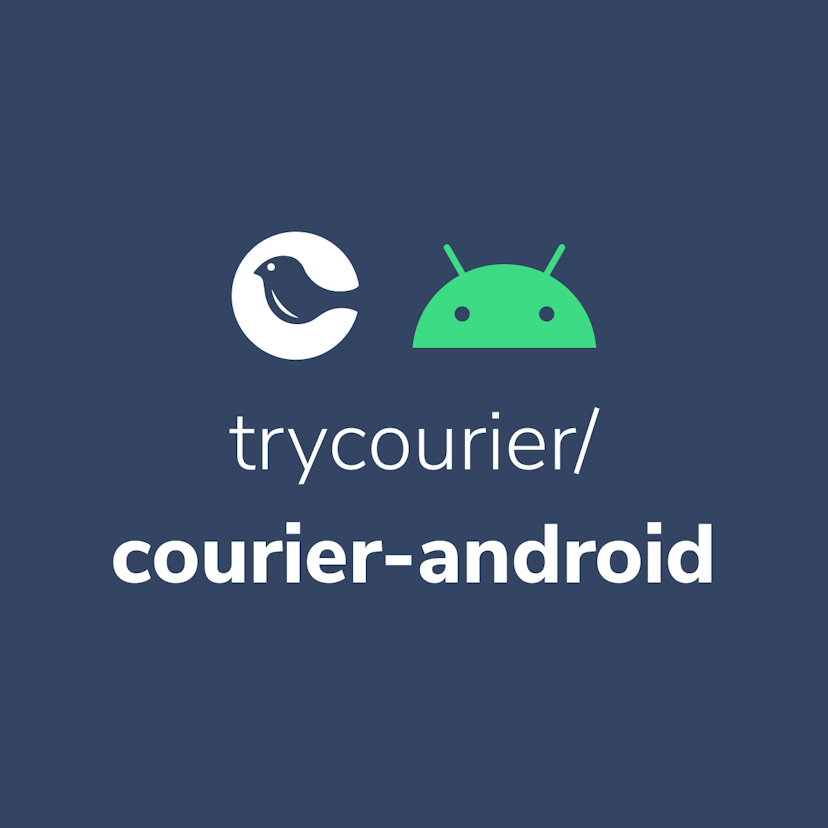
Building Android push notifications with Firebase and Courier’s SDK
Push notifications have become an essential part of modern mobile apps, allowing you to keep your users engaged and informed. However, implementing push for different platforms can be a complex and time-consuming task, requiring developers to set up and handle token management, testing, and other logistical details.
Mike Miller
March 21, 2023
Free Tools
Comparison Guides
Build your first notification in minutes
Send up to 10,000 notifications every month, for free.
Get started for free

Build your first notification in minutes
Send up to 10,000 notifications every month, for free.
Get started for free

© 2024 Courier. All rights reserved.